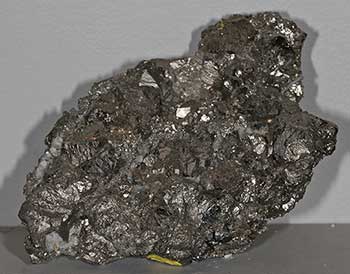 |
| Linnaeite - Co3S4. |
Cobalt is a bluish-gray, shiny, brittle metallic element. Its atomic number is 27 and its symbol is Co. It belongs to a group of elements called the transition metals. It has magnetic properties like iron.
Ancient civilizations in Egypt and Mesopotamia used a substance to color glass a beautiful deep blue. In 1735, the Swedish scientist Georg Brandt set out to prove that this color was due not to the element bismuth, as people believed, but to a new and unidentified element. He is credited with the discovery of this new element, which he named cobalt.
Cobalt is one of the elements that is very important to life, including human life and health. Vitamin B-12 contains cobalt. In areas where there is little cobalt in the soil, farmers have to provide salt blocks containing cobalt for their animals to lick in order to provide enough cobalt in their diet.
Cobalt is also found in iron-nickel meteorites.
Name
Cobalt was named after the German word kobald which means goblin or evil spirit believed to cause health problems for silver and copper miners.
Sources
It is estimated that there are about 1 million tons of cobalt in the United States. Minnesota has the largest resources, but other ore resources are found in Alaska, California, Idaho, Missouri, Montana and Oregon. The identified cobalt resources in the world total about 15 million tons. Most are found in Australia, Canada, Congo, Russia, and Zambia.
The ocean floor has nodules of metals that form when hot water from deep in the Earth comes into contact with the cold ocean water. These nodules are mostly manganese and so are called manganese nodules. It is estimated that there are millions of tons of cobalt in these nodules. Presently, we do not have the technology to retrieve these nodules at a reasonable cost.
All of the primary cobalt used in the U.S. is imported. Cobalt is imported into the United States in the form of cobalt metal, cobalt salts, and cobalt oxide. The imports come from Norway, Finland, Canada, Russia, and other nations.
Uses
Cobalt has been used by civilizations for centuries to create beautiful deep blue glass, ceramics, pottery and tiles. In a similar way, it is being used to make paint pigments.
In addition to these traditional uses, cobalt is used in a number of industrial applications. When cobalt is alloyed with other metals, very strong magnets are created. Superalloys containing cobalt are used in the production of jet engines and gas turbine engines for energy generation. These superalloys account for nearly half of the cobalt used each year. Some cobalt is used to make cutting and wear-resistant materials.
A manmade isotope of cobalt, cobalt-60, produces gamma rays. This is used for sterilization of medical supplies and foods, for industrial testing, and to fight cancer.
Substitutes and Alternative Sources
At times, cobalt prices rise significantly and there is concern about the amount of cobalt easily available around the world. As a result, industries have tried to conserve cobalt consumption. There are some replacements for cobalt, but they don't always work as well as cobalt. For example, nickel-iron or neodymium-iron-boron alloys can be used to make strong magnets. Nickel and special ceramics can be used to make cutting and wear-resistant materials. Nickel-base alloys containing little or no cobalt can be used in jet engines. Manganese, iron, cerium, or zirconium can be used in paint driers.